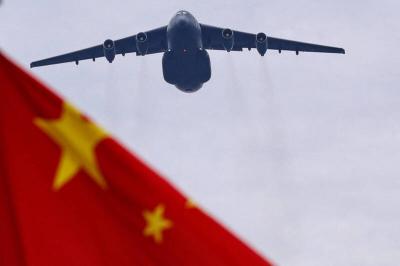The air force yesterday scrambled to intercept Chinese jets that flew around Taiwan in a move denounced by the Ministry of National Defense as a threat to regional peace and stability.
China has been flying what it calls “island encirclement” drills on-off since 2016, when President Tsai Ing-wen (蔡英文) of the Democratic Progressive Party first took office. She was re-elected on Jan. 11.
The ministry said in a statement that Chinese J-11 fighters and H-6 bombers flew into the Bashi Channel to the south of Taiwan, then out into the Pacific Ocean before heading back to base via the Miyako Strait, between Japan’s Miyako and Okinawa islands, to the northeast of Taiwan.
“During this period, the national military used air reconnaissance aircraft and air defense forces in accordance with combat readiness regulations,” it said.
The ministry provided a picture of a Taiwanese F-16 shadowing one of the Chinese H-6 bombers.
“The Chinese communists’ long-range far-out-at-sea missions have impacted regional security and stability, and endanger the peace and welfare shared by all parties in the region,” the ministry said.
There was no immediate comment from the Chinese Ministry of National Defense.
China has brushed off such drills in the past as nothing out of the ordinary.

Beijing could eventually see a full amphibious invasion of Taiwan as the only "prudent" way to bring about unification, the US Department of Defense said in a newly released annual report to Congress. The Pentagon's "Annual Report to Congress: Military and Security Developments Involving the People's Republic of China 2025," was in many ways similar to last year’s report but reorganized the analysis of the options China has to take over Taiwan. Generally, according to the report, Chinese leaders view the People's Liberation Army's (PLA) capabilities for a Taiwan campaign as improving, but they remain uncertain about its readiness to successfully seize

Taiwan is getting a day off on Christmas for the first time in 25 years. The change comes after opposition parties passed a law earlier this year to add or restore five public holidays, including Constitution Day, which falls on today, Dec. 25. The day marks the 1947 adoption of the constitution of the Republic of China, as the government in Taipei is formally known. Back then the Chinese Nationalist Party (KMT) governed China from Nanjing. When the KMT, now an opposition party in Taiwan, passed the legislation on holidays, it said that they would help “commemorate the history of national development.” That

HORROR STORIES: One victim recounted not realizing they had been stabbed and seeing people bleeding, while another recalled breaking down in tears after fleeing A man on Friday died after he tried to fight the knife-wielding suspect who went on a stabbing spree near two of Taipei’s busiest metro stations, Taipei Mayor Chiang Wan-an (蔣萬安) said. The 57-year-old man, identified by his family name, Yu (余), encountered the suspect at Exit M7 of Taipei Main Station and immediately tried to stop him, but was fatally wounded and later died, Chiang said, calling the incident “heartbreaking.” Yu’s family would receive at least NT$5 million (US$158,584) in compensation through the Taipei Rapid Transit Corp’s (TRTC) insurance coverage, he said after convening an emergency security response meeting yesterday morning. National

Taiwan has overtaken South Korea this year in per capita income for the first time in 23 years, IMF data showed. Per capita income is a nation’s GDP divided by the total population, used to compare average wealth levels across countries. Taiwan also beat Japan this year on per capita income, after surpassing it for the first time last year, US magazine Newsweek reported yesterday. Across Asia, Taiwan ranked fourth for per capita income at US$37,827 this year due to sustained economic growth, the report said. In the top three spots were Singapore, Macau and Hong Kong, it said. South